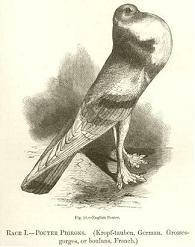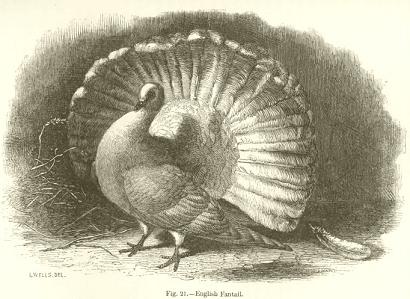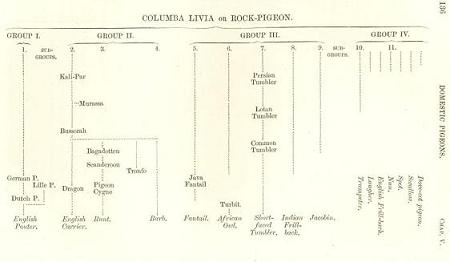
Natural selection needs variation to act. Victorian scientists however thought that individuals of a species were not variable to any extent where it might be important. One of Darwin’s major achievements was to change this view and make biologists think about individuals rather than about populations or species as a whole. His work on variation was typical of the man; he collected lots of facts, and performed lots of experiments. One of his key study organisms was the fancy pigeon, which Darwin found to be a fountain of variation and also a ‘great treat’.
The Need To Study Variation
For evolution by natural selection to occur individuals of a species must be variable. Slight differences in size, colour, behaviour, physiology and all the other components of living things must exist. Furthermore these variations must be evolutionarily meaningful; that means two things:
- they have to have some effect on survival and reproductive success
- these differences must be heritable; they have to be passed on from parent to offspring
The existence of variation may not seem like a major problem now; scientists have become very used to thinking about species in a way known as ‘population thinking’. Population thinking emphasizes the uniqueness of each individual within a population. For example when you see lions on a TV documentary it’s clear some are bigger than others, or better hunters, or better parents, some are more aggressive to other lions and some sleep more than others.
This may seem like an obvious way to view species, but Darwin was the first scientist to really see this; it was one of his greatest observations. Darwin’s peers, from the great Victorian naturalists to the beetle collectors and village parsons who dabbled in science, all agreed: species were species. They ascribed to a school of thought (to varying degrees) known as ‘essentialism’. The same logic that led Pythagoras to state that a triangle is always a triangle led Victorian scientists to consider a species as a fixed type or ‘natural kind’.
The predominance of essentialism posed a serious problem for Darwin. If essentialism was correct, if species are fixed, if a lion is and has always been a lion in its present state there can obviously be no evolution; a new species could only come to be if it was created in its modern form.
Not only did Darwin’s theory argue that species were not fixed and that they did evolve, but his mechanism for evolution, natural selection, was based on small differences between individuals of the same species. This posed three further problems: first of all, what differences? If species varied to an extent that they could change, why had no one noticed before? Secondly, natural selection depends on individuals of the same species competing and out doing each other. But to Victorian eyes the natural world was harmonious; they saw no struggle for existence. Finally, an animal or plant works as a unit; if you change one bit, won’t it affect all the others?
It would be no good for Darwin to present the bones of his theory and hope, in time, people would come to accept it, because they probably wouldn’t have. The vast majority of scientists just weren’t looking at the living world in the right way. Darwin himself would have to change this, he would have to provide the evidence and the argument to persuade the world that:
- individuals of a species vary (a lot)
- this variation affects the individual's survival and the number of offspring it has (even just a little)
- this variation is heritable and can be additive
- selection can act on particular traits independently from the rest of the organism
Luckily, there was ample proof available, and it was already familiar to most people. Darwin’s proof of concept lay in wheat, rice, cows, sheep, chickens and pigeons: the products of domestication of wild animals and plants by artificial selection.
Darwin’s Strategy
Darwin’s strategy to persuade his readers of the scope for natural selection to act had from quite early on been by analogy with artificial selection. For thousands of years man had selected crops to improve yields and selected animals to provide food, clothing, company and to behave in a way that makes them easy to farm. Darwin would use the domestic animals and plants to show that variation does exist and it has the right characteristics to allow natural selection to act. If variation exists for artificial selection to work, there is no reason why natural selection can’t.

His strategy had two parts. First he would document evidence that variation exists in domestic animals and plants. To do this he utilised his old network of contacts from his barnacle research, sending out for carcasses of ducks, sheep and all sorts, to be sent to his house where he would take detailed measurements of their skeletons. He called on experts, sending out letters of requests for information in farming and country journals and wrote directly to hundreds of peoples quizzing them on their animals and plants.
The second phase of his strategy was to discuss the power of artificial selection to modify domestic species in almost any way: ‘the key is man’s power of accumulative selection: nature gives successive variations, man adds them up in certain directions useful to him’. He would show that variation is there, but that it is not controlled by the breeder. The breeder merely selects favoured traits from variation that is produced naturally. The key point here is that variation allows selection; it occurs naturally and ubiquitously and has the right characteristics that allow the selection of traits in a quasi-independent way from other traits.
One of the key organisms in Darwin’s study of variation was the domesticated pigeon. It was at the pigeon that Darwin directed his most scrutinising gaze, and with dividends. His studies of different pigeon breeds provided him with the evidence for meaningful variation that he needed, evidence enough to take up almost two full chapters of The Origin with enough spare to be a major focus of The Variation.
Darwin & The Pigeons
‘Believing that it is always best to study some special group, I have, after deliberation, taken up domestic pigeons’. So begins Darwin’s most complete example of his analogy between natural and artificial selection, such a thorough treatment that Darwin’s editor, after reading the first chapter, thought that the book’s main subject was the pigeon.
Darwin’s foray into pigeons started in March 1855, strictly as a means of collecting facts: there was to be 'no amusement'. To begin with he used his contacts from the barnacle years and some new ones acquired through friends and friends of friends to rekindle his postal-network. He sent letters to breeders and other experts asking for facts and where possible skins and skeletons for him to measure.
Soon though, as with most of Darwin’s studies, he became engrossed and set up an elaborate pigeon house at Down House, buying pigeons of many different breeds to perform his own crosses and experiments. The ‘no amusement’ plan quickly went out of the window; in November 1855 he wrote to his friend Charles Lyell, who was planning a visit, ‘I will show you my pigeons! Which are the greatest treat, in my opinion, which can be offered to a human being’. All the family, especially the children, delighted in Charles’ latest quarry.

His enthusiasm led him to join at least two societies of pigeon fanciers and he frequently visited others. At this time, Columbarian societies, as they are known, were dominated by class; there were clubs for gentlemen, and clubs for working men. Darwin went to both, socialising with and mining information from all types of men, all the ‘odd specimens of the Human species, who fancy pigeons’. When he received or asked for help from those who were less well off he always refunded them any costs they encountered. By seeking help from all quarters Darwin ensured his knowledge of pigeons was as complete as it could possibly be. With an army of fact gatherers, and skins and skeletons of pigeons and other domestic animals arriving daily by post he quickly amassed a mountain of facts he needed to discuss variation.
Why Pigeons?
Darwin answers this in The Origin: ‘the diversity of the breeds is something astonishing’. There are many, many breeds of domestic pigeons all with different appearances and behaviours. Almost any anatomical feature is different between the breeds; beak size and shape, feather coloration, feather orientation, some have feather feet, some scaly feet, some webbed feet, some are very thin and tall, others fatter and larger, some have enlarged nasal skin appendages, some can expand their throats into a puff almost the size of their bodies, some have tail feathers which fan out like a peacock, almost all bones vary in dimension. Even behaviours change: some have odd coos, others have an odd flight pattern where they ‘tumble’ out of the sky. They even grow at different rates, and hatch at differing stages of development.
Yet despite this mass of variation, all pigeon breeds are descended from one wild pigeon species; Columba livia, the rock pigeon, which lacks all these fancy characters. In the 1850s there was a debate over whether or not all pigeon breeds descended from one stock. Most naturalists believed they were, but most pigeon fanciers believed they were descended from probably 7 or 8 species, and felt the naturalists too quickly dismissed domestic animals and made sweeping generalisations. When Darwin first started his pigeon work, he claims to have ‘felt fully as much difficulty in believing that they could have descended from a common parent, as any naturalist could in coming to a similar conclusion in regard to many species of finches’. But in the opening chapter of The Origin he laid out an argument showing that they were in fact one species.
This argument was based on a number of observations. For example he noticed the reversion of feral pigeons to appearances similar to that of the rock pigeon. He also concluded that all breeds can mate and produce fertile young. In addition he thought domesticating one species was difficult enough let alone seven or eight, and found no evidence for ancestry with any other birds than the rock-pigeon.

By uniting the breeds under one species, Darwin could then use the pigeons to show various points. First, he drew an analogy between the breeders' disbelief in all breeds being from one common ancestor, and that of naturalists and their similar disbelief about species of wild animals and plants: ‘may not those naturalists… learn a lesson of caution when they deride the idea of species in a state of nature being lineal descendents of other species?’. As an aside, Darwin produced a tree showing the relationship between the pigeon breeds; the first evolutionary tree for any real group of animals.
Second, he showed that amongst breeds of pigeons, breeders have been able of select for a vast number of traits, in almost any body part, and in behaviour. The discrete differences among breeds are linked by smaller, continuous differences among sub-breeds. Within breeds and sub-breeds, the traits which differ most between the breeds are often the most variable. This proved that naturally-produced variation has the properties needed to allow selection to occur, and for change to occur gradually, over many generations. If humans have been able to bring about such change in a few thousand years, why then couldn’t the natural processes of competition and death, acting over much longer times, not bring about the same change?
What Did Darwin Learn? How Did It Help His Theory?
The demonstration that variation occurs naturally and has the right properties to allow selection to occur is a key point. Having established this fact, Darwin could move on to wild animals where he showed that just as much variation occurs within species as it does within breeds of pigeons, sheep, cows, wheat or geranium. This variation was the key to evolution, but had been overlooked by scientists until Darwin shed light on its importance. In The Origin, Darwin would combine the presence of variation, with the over-production of young and the struggle for survival to show that evolution by natural selection is an inevitable fact.
His work on variation was started when Darwin planned to write a massive tome, a book so large and full of evidence for evolution that it would be accepted by all. The emergence of Alfred Russell Wallace, and the realisation that another scientist had come to the same conclusions as he had rushed Darwin to produce an ‘abstract’ of this great book; this became On the Origin of Species. Only a fraction of Darwin’s study on variation made it into this book. Much of the rest appeared in The Variation of Animals and Plants Under Domestication (1868). Here Darwin presented all his views and facts on variation and the laws governing it and proposed a theory of inheritance – the missing link in his theory of evolution – which he called Pangenesis.
Written by Stephen Montgomery
References & Further Reading
The Autobiography of Charles Darwin
by Charles Darwin (Edited by Francis Darwin), The Thinker's Library: 1929
Darwin
by John van Wyhe, Andre Deutsch: 2009
Darwin
by Adrian Desmond & James Moore, Penguin: 1991
Darwin's Islands: The Galapagos in the Garden of England
by Steve Jones, Little, Brown: 2009
Journal of Researches
by Charles Darwin, 1839 (any edition)
On the Origin of Species
by Charles Darwin, 1859 (any reprint - 2nd edition preferable)
The Variation of Animals and Plants Under Domestication (Vol I & II)
by Charles Darwin, 1868 (any edition)